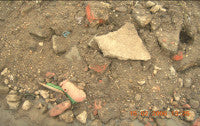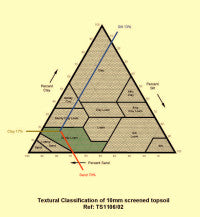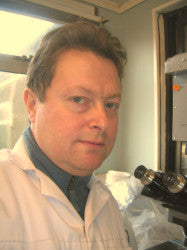What is meant by quality topsoil?
 The British standard BS3882: 1994 states that "Naturally occurring topsoil is the dynamic product of chemical, physical, and biological processes. It is the result of interaction between the inherent nature of the parent material and the prevailing environment (including human activity and vegetation)." It goes on to state that "The properties of topsoil may thus change if one or more of these factors changes.
The British standard BS3882: 1994 states that "Naturally occurring topsoil is the dynamic product of chemical, physical, and biological processes. It is the result of interaction between the inherent nature of the parent material and the prevailing environment (including human activity and vegetation)." It goes on to state that "The properties of topsoil may thus change if one or more of these factors changes.
For example, if a topsoil was stripped and transported to a new location, spread in a different topographic or drainage situation and planted with a different vegetation, the topsoil that develops would become very different to the one that was lifted." The quality grades of soil are defined as premium, standard and economy.
The parameters are based on the physical structure, organic matter content, pH and potential contaminants. The British Standard for topsoil states that "Premium grade is a natural topsoil. It is of high intrinsic fertility, loamy texture and of good structure. It has the capacity and in the right site and climate to be used in plant nurseries, gardens, horticulture, amenity and landscaping sites where it is intended to grow the most demanding plants or where the topsoil may be subject to intensive or frequent cultivation, e.g. annual bedding.
This high quality may be unnecessary for the majority of topsoil applications where other grades may be entirely satisfactory." It goes on to add that "premium grade is the most limited in supply and that, if handled or badly stored, premium grade topsoil can change into one of the other grades. Therefore, suppliers responsible for processing and providing topsoil must be proficient in the soil's handling and storage."
Turfcare professionals need to have high confidence in the materials they are working with. High quality topsoil is one of the main ingredients in rootzone and topdressing. One organisation currently working towards setting the quality standards in the topdressing & rootzone manufacturing industry, is BRTMA - the British Rootzone and Topdressing Manufacturers Association.
Ideally, the minimum standard for the rootzone and top-dressing manufacturing industry would be that the end product would always be produced using the best components available. These should conform to an agreed specification for quality control purposes. In the past this has not always been the case. One reason being the use of inferior materials to economise on manufacturing costs.
This frequently applies to the soil blended into these products. Soil of doubtful provenance can often be derived from root vegetable washing, as a by-product of the food production industry.
Companies that hire skips can often sell topsoil as a sideline; the contents of the filled skips are passed through a screener, the result being sold as 'topsoil'. Silt from river dredging has been discovered being sold as topsoil. All these products are usually high in silt and clay, in the case of vegetable washings there is often a high salt content.

Soil that has been lifted from brown field/ex-industrial sites is being offered as premium grade topsoil. The lead photograph of this article is an actual case of this. One of the functions of organisations such as the British Topsoil Suppliers Association (BTSA) or BRTMA is to prevent this material finding its way into the market place.
Poor quality topsoil substitutes can possess high levels of salts as measured by the soil's Electrical Conductivity, the units being mS cm-1. Genuine topsoil will usually give a reading in the range of 250 - 800 mS cm-1. Vegetable washings sold as topsoil have been measured in excess of 2700 mS cm-1. Partly this is because lime is used in the cultivation process.
What are the effects of high salt concentration on plant health? One of the main effects is that high salinity interferes with Ion exchange by raising the osmotic potential. This has the effect of hindering the plant's ability to absorb nutrients in the form of dissolved mineral ions via the root system. In the case of turf this will produce weaker turfgrass with a greater susceptibility to disease.
A specification sheet provided by the supplier should show the Particle Size Distribution (PSD), the pH, the percentage content of organic matter and the electrical conductivity. Nutrient levels such as Magnesium (Mg), Potassium (K) Phosphorous (P) and Nitrogen (N) should also be shown on the specification sheet. The PSD will give an indication of the silt and clay content.
The effects of high concentrations of the finest particles in a soil will affect the drainage and gas permeability of the growing medium. Heavy clay soils will be slippery when wet and will be slow draining. When these soils dry out in hot summer conditions, which are becoming more prevalent with global climate change, they set rock hard, which is both unsuitable for most sports playing surfaces (with the obvious exceptions of cricket wickets and tennis courts) and does not promote healthy turf. Slow draining heavy soils do not allow air to reach the soil organisms that break down organic matter to become available nutrients for plant uptake.
 Organic matter acts as the cementing agent that causes fine particles to bind together into aggregates. Therefore, in physical terms, the OM content is significant because it is difficult to maintain good soil structure in soils low or devoid of organic matter.
Organic matter acts as the cementing agent that causes fine particles to bind together into aggregates. Therefore, in physical terms, the OM content is significant because it is difficult to maintain good soil structure in soils low or devoid of organic matter.
Correctly ascertaining a soil's pH is a necessary requirement due to the fact that, at higher pH levels, certain nutrients react with other compounds present in the soil and become unavailable for uptake by plants. Adjustment of the soil pH will result in the release of these nutrients back into soil solution.
This adjustment is not necessary if the soil used has a sufficiently low pH value. It is also the case that fine turf cultivars such as those found on golf greens require slightly acidic conditions. This is, in part, because of the wild grass species that the turf cultivars are derived from, were evolved to grow in upland, acidic conditions, It is also the case that the level of microbial activity in the soil, is also pH dependent.
So be aware, ask questions of your supplier. It is simply not enough to rely on the paperwork, it is a good idea to visit your intended supplier's works, inspect the production facility, find out if their other customers are happy with the supplied product, and where the soil comes from originally? Inspect it yourself - are there roots present? Does it contain Bracken (Pteridium aquilinum), Mares-tail (Equisetum arvense) or worse still - Japanese knotweed (Polygonium japonicum)? At the very least, request that a sample be sent to you. If a recent specification sheet is unavailable, then you should ask why. Find out what soil associations the supplier belongs to.
Substandard and unsuitable material is being sold to the unwary as premium grade topsoil - make sure your job doesn't receive it. The origin of doubtful quality soil is obviously unreported by unscrupulous suppliers, therefore these checks are essential.

The standard that the laboratory contaminant results are compared against is DEFRA's Contaminated Land Exposure Assessment Soil Guideline Values intervention levels (CLEA SGV's). If the concentration of a contaminant rises above the prescribed value, then that substance is deemed to be present at unacceptably high concentration for the soil's intended purpose. The SGV will vary according to the use that the soil will be put to.
These categories are - Residential, Allotments and commercial/industrial - the sports turf industry falling into the last category.
Because of the increasing supply of material described as 'topsoil' the British Topsoil Suppliers Association was set up. It ensures that its members only supply true, genuine topsoil. It will not have been obtained from a dubious source, thus the product supplied is able to be classified as 'true topsoil'. The members achieve this by regular quality control monitoring and being aware of the soil's original source. It is also worth mentioning that having a current specification sheet increases confidence of both the intermediary and the final user, for the material supplied.
Having this information available to the end user, in the form of a current full specification sheet, is becoming significant as more soil of unspecified provenance appears on the market.
For copies of SGVs and other technical material referred to here see: - www.environment-agency.gov.uk/subjects/landquality/113813/672771/
Nigel Fahey B.Sc. is the laboratory manager for Baileys of Norfolk, a founder member of the BTSA & BRTMA.
Article Tags:
Industry news